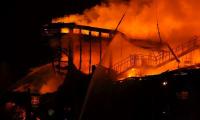IS-inspired fighters, mean that the window of opportunity for Ghani and Abdullah to broker a peace with warring militants, acceptable to all Afghan camps, is closing and will reopen next spring.
For Kabul then, one avenue for recourse is building up the ANSF. A fortnight ahead of Ghani’s power trip to New Delhi, three Indian-made multi-role Cheetal helicopters were formally added to a burgeoning Afghan Air Force fleet.
But Indian offers for equipment are just as likely to affect, or upset, peace outcomes in Afghanistan. President Ghani turned down an earlier Made-in-India defence offer in a bid to rebuild bridges with Pakistan. The Indian desire for access to Middle Asia, however, is already finding ways to circumvent Islamabad – through Chhabahar – and chip away at Kabul’s cautiousness. The longer the Taliban hold Kunduz and Baghlan to ransom, the louder Kabul is likely to clamour for defence hardware, irrespective of the seller.
For Pakistan, an expanded Indian security role in Afghanistan will remain a strategic concern, and the recently reset Pak-Afghan relationship will certainly be tempered by the latitude given by President Ghani to eager Indian defence vendors.
India is presently Afghanistan’s sixth largest donor, having invested over $2 billion in aid and reconstruction. And in the coming months it is the ANSF’s performance in battlegrounds such as Kunduz that will determine precisely how Kabul articulates its defence needs to regional allies.
India simultaneously needs to shake off old anxieties; there is value in seeing a culmination to the Taliban insurgency that includes the possibility of reconciliation, provided this is Afghan-led, and Afghan-owned. A stable political dispensation in Kabul, after all, rides high in South Asia’s long list of policy prerogatives; but breaking with the past to bend the arc of the regional landscape towards stability will be a challenge. New Delhi for instance will have to reconcile with the Ghani administration’s apparent desire to go the 1+4 mile – focus on bringing the Taliban to a negotiating table, while leveraging extra-regional Chinese, Pakistani, Iranian, and Saudi influences to make this happen.
But President Ghani will also have to rethink counterterror policy in his country’s eastern flank. As long as the TTP continues to ride out the full force of Operation Zarb-e-Azb, by seeking refuge in the forests of Kunar and Nuristan, the health of the Afghan Taliban insurgency will remain tied to Ghani’s ability to renegotiate Afghanistan’s eastern spaces away from the grip of non-state actors.
For an Afghan-owned peace to break even and fighting to end, the prerogative for an intra-Afghan dialogue must be Afghanistan’s alone. Ghani, however, will have to ensure that negotiation does not come at the cost of fundamental human – and women’s – rights.
This will necessitate inclusive leadership that accommodates all voices within the Afghan polity, and a stronger ANSF military that can support the National Unity Government in its climb out of chaos. But it will also mean leveraging regional relationships in a manner that corresponds with reconciliation lobbies at home – a feat Karzai failed to pull off.
The writer works for Jinnah Institute. He tweets @fahdhumayun
This demand has fueled rapid growth deposit base of Islamic Banks and Islamic Windows operated by conventional banks
But Punjab Agriculture Food and Drug Authority building near Thokar Niazbeg on Multan Road stands out
Macron has been particularly vocal in their criticism, asserting that withholding arms from Kyiv plays directly into...
As PPP governs province, Bilawal Bhutto Zardari holds strategic position to address both violence and its underlying...
Critics argue that strategy is vague, but closer look indicates strategic alignment with global trends and national...
To defeat it, we must distrust bot-driven narratives, to defeat it, we must verify sources before believing or sharing







